Broadleaf Plantain – The “Weed” You Won’t Want to Be Without
Some may view this humble plant as “just a weed”, but once you learn about the wide range of benefits and uses of broadleaf plantain, you’ll never want to be without it. From nutritious leafy greens to soothing healer inside and out, this wild plant is a blessing is disguise. In this post, we’ll share how to identify plantain herb, broadleaf plantain benefits and how to manage it in the yard and garden.
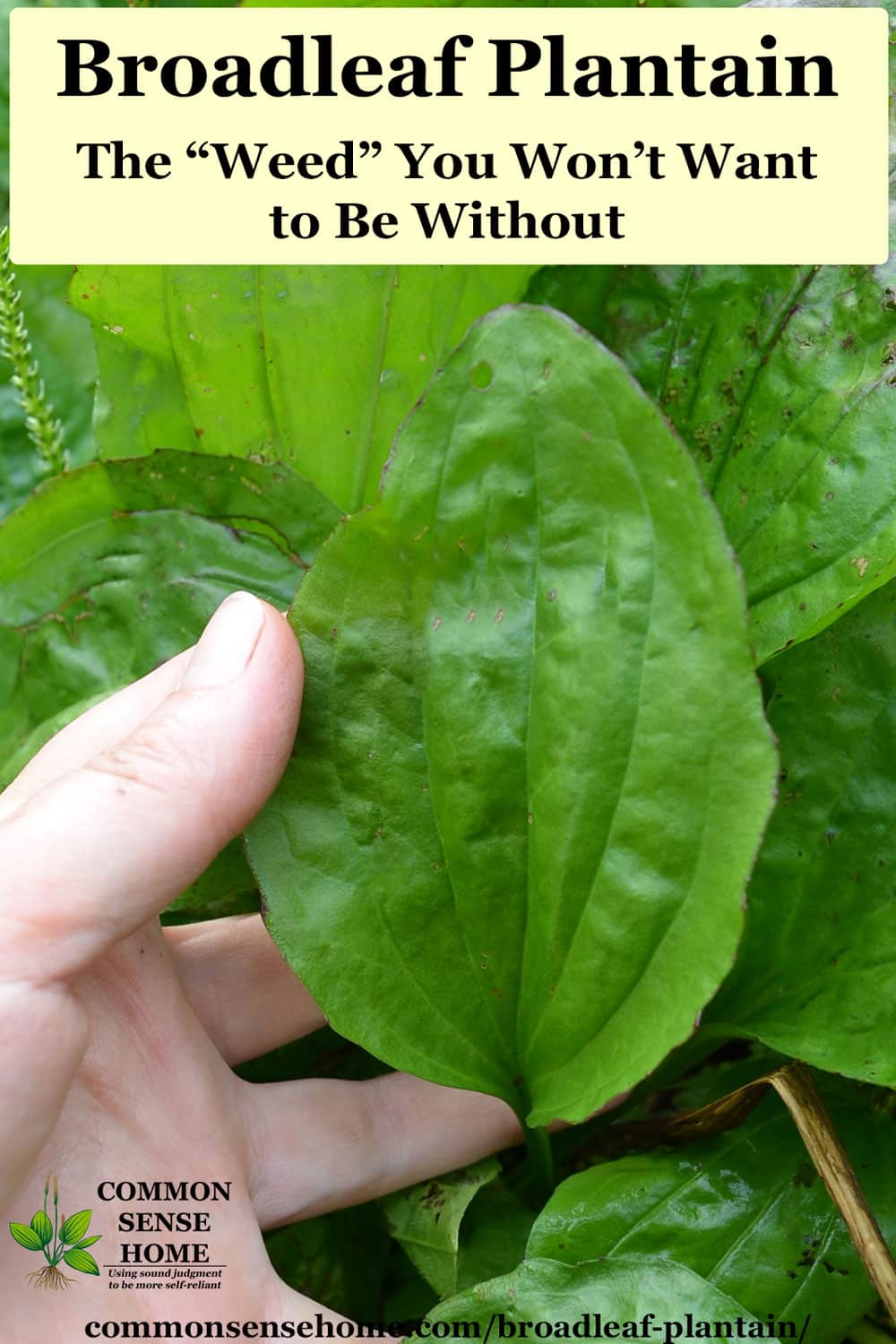
How to Identify Plantain Herb
Broadleaf plantain (Plantago major) is one of thirty-four Plantago species around the globe – all of them edible and medicinal.
Where Broadleaf Plantain Grows
Broadleaf plantain is native to Europe and temperate parts of Asia. It (and other plantain species) have spread to most of the world, except the arctic regions. They grow throughout most of the United States and North America.
Plantain grows just about anywhere – from cracks in sidewalks, to roadsides and meadows, to garden beds and lawns. (We have some suggestions for plantain control near the end of the post.)
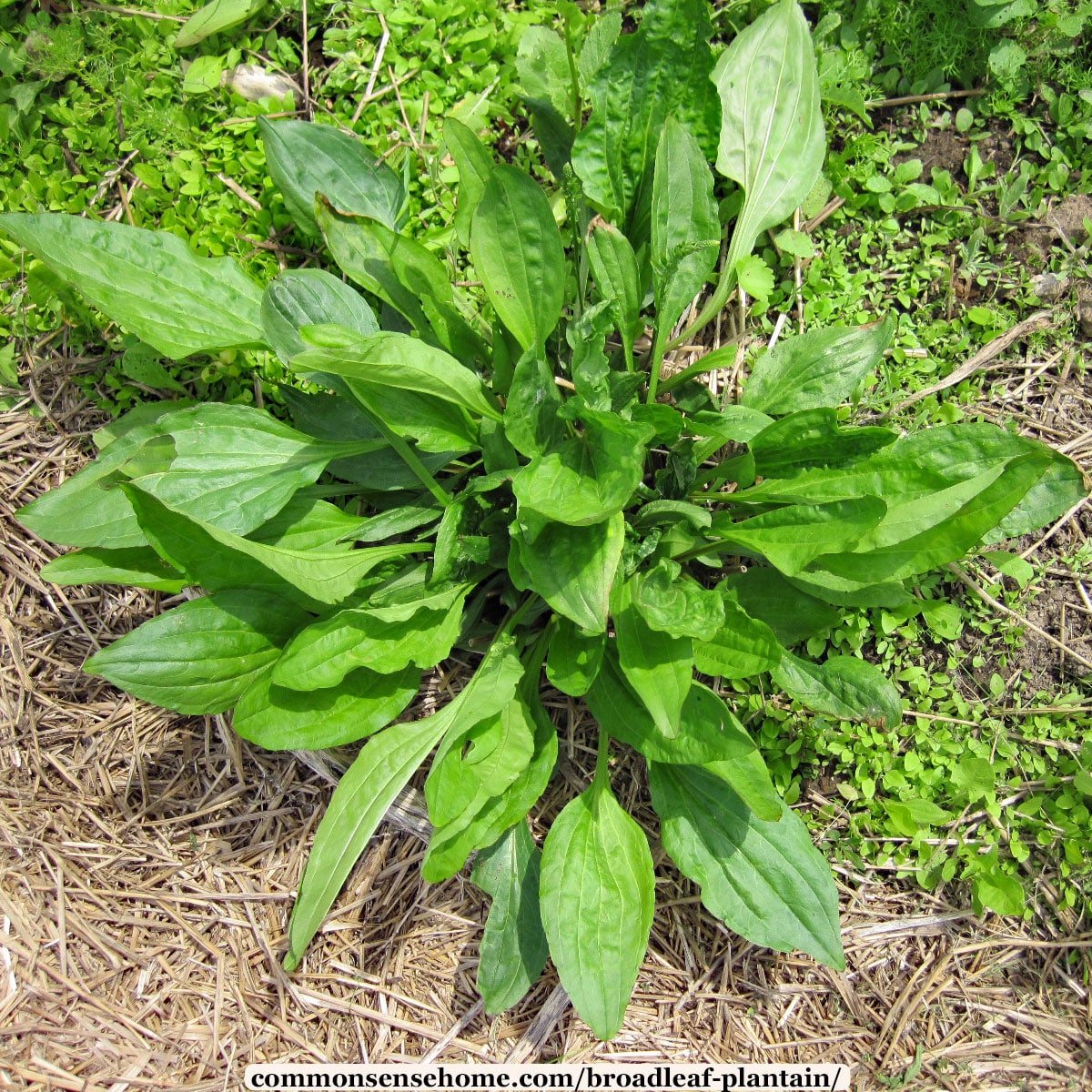
What Plantain Herb Looks Like
Broadleaf plantain is a perennial, coming back year after year from the roots. Leaves grow in a rosette, close to the ground. Plantain leaves are 1-6 inches in length, broadly lance shaped to egg shaped, and are hairless or sparsely short haired.
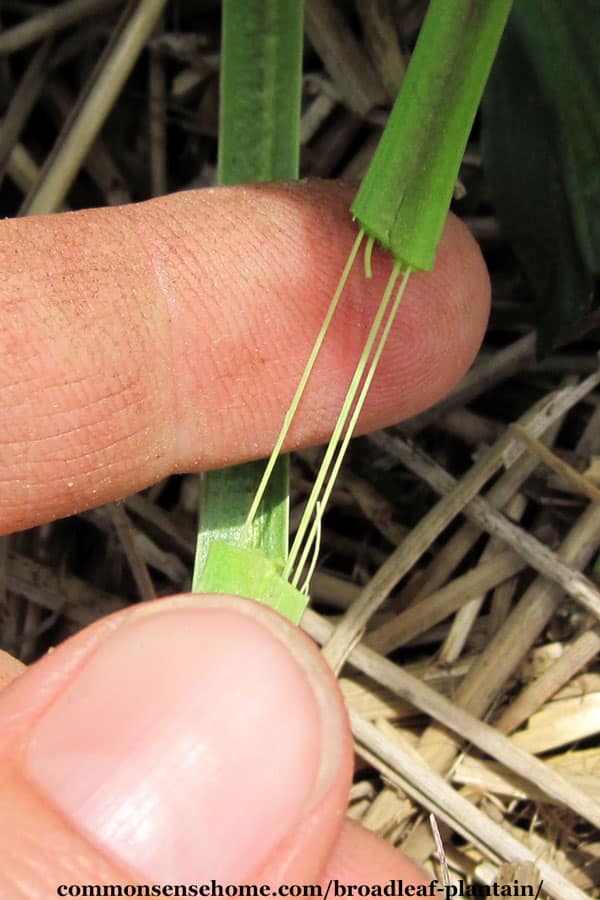
Each leaf has prominent parallel veins, like celery. If you break a leaf in half, it has strings.
The flowers shoot up from the center of the basal rosettes in spikes 3-12 inches tall. They’re rather dull colored, changing from green to brown as the seeds mature.

The small brown seed pods each contain 4-20 seeds. When they mature, pods split open and spill the seeds to the ground. Plantain seeds can last at least 60 years in the soil, so if you’ve had plantain show up in your garden once, chances are you’ll see it again, even if you don’t let new plants go to seed.

Buckhorn plantain (Plantago lanceolata) is another common plantain species. It’s also called ribwort or narrow leaf plantain. As the name suggests, this plantain has longer, narrower, lance shaped leaves. It also forms a rosette of leaves with veins from the base to tip.
Broadleaf Plantain Benefits
Broadleaf plantain is edible for both animals and people, and has a wide range of medicinal uses.
Nutrient Dense Food
The entire broadleaf plantain plant is edible from root to seed. Nutrients include vitamin A, as well as vitamins C and K, zinc, potassium, and silica. Plantain seeds are rich in proteins, carbohydrates and omega 3 fatty acids.
Young plantain leaves can be eaten raw. They make flavorful salad greens, pairing well with other milder greens or fruits like diced apple. As the plant gets older, the leaves get tougher, and are better cooked. Chop them (remember the strings) and use them as you would spinach or other sturdy greens.
Plantain roots are small compared to many wild plant roots, but they can be cooked and blended into soups and vegetable dishes.
The seeds of Plantago major are related to Plantago ovata, or psyllium seeds. (These are used in popular fiber supplements.) Their seed coat contains up to 30% mucilage, giving it a gelatinous quality when wet. You can grind up plantain seeds in their husks to use as thickening in recipes, or as part of a hot porridge mix.
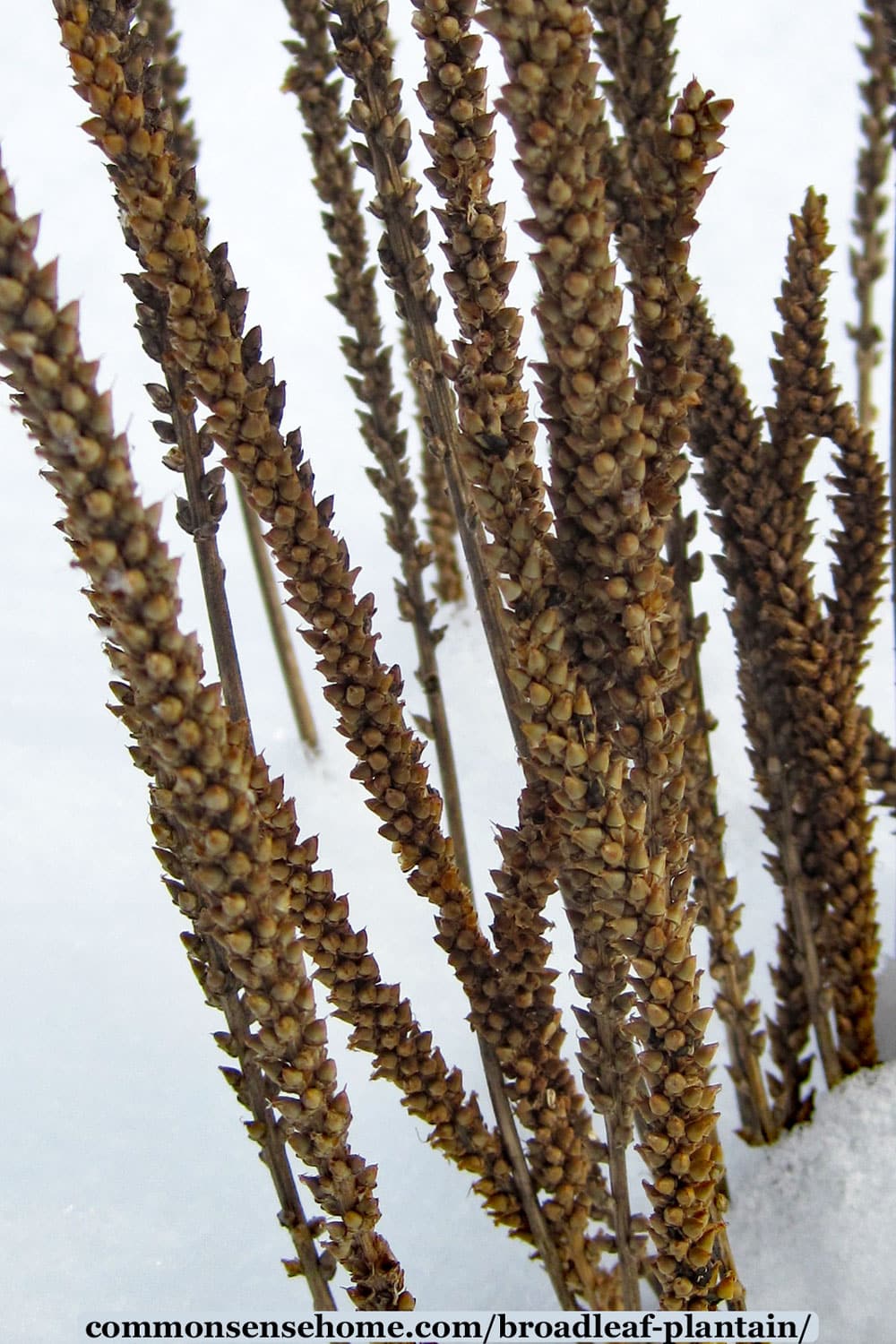
Wildlife Eats Plantain, Too!
Cardinals, sparrows and other small birds munch on plantain seeds. Many herbivores such as groundhogs, rabbits, deer, cattle, sheep and other mammals eat the leaves and flowering stalks. Caterpillars of buckeye butterflies and several moths eat the leaves. (Source)
Plantain Herb as Medicine
Broadleaf plantain is nothing short of AMAZING for bug bites, stings and other skin irritations. I use fresh plantain leaf directly on insect bites, or plantain infused oil or salve. The itch of mosquitoes bites and burn of wasp stings fades in minutes with an application of plantain herb.
Would you like to save this?
Plantain salve made from infused oil is great for spot treatments and hemorrhoids. I dry some plantain for tea, too, but most frequently I use it fresh or in salve.
Plantain is also good for drawing out slivers. Simply place some fresh, smashed plantain or plantain salve on the sliver spot, cover with a bandage, and leave overnight. The next morning you should be able to gently squeeze out the sliver or pluck it from the wound.
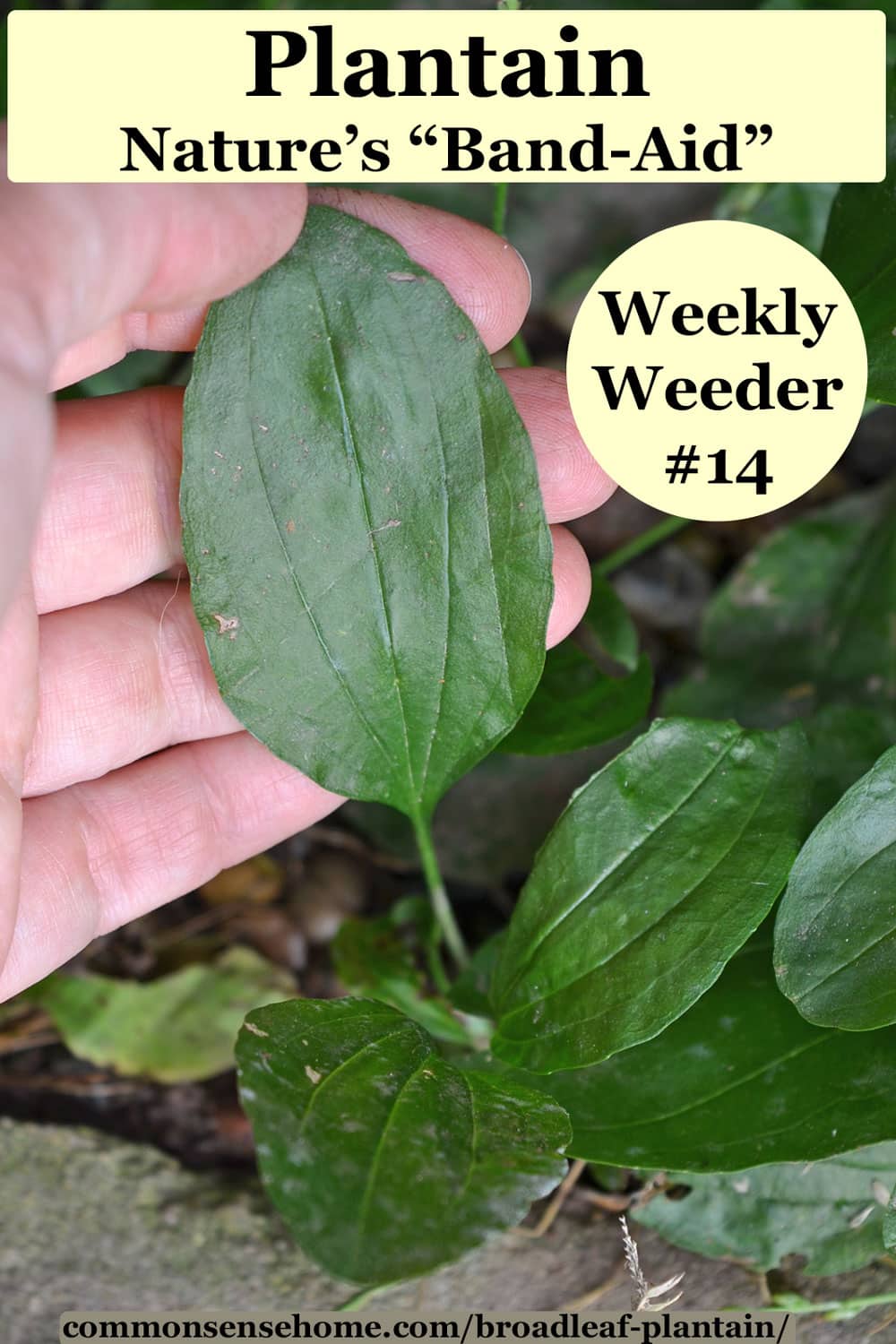
Plantain is also used medicinally to:
- inhibit bacteria growth
- counteract poisoning
- relieve pain and inflammation
- clear obstructions in the gut and airways
- increase the flow of urine
- reduce fever
- stop bleeding
- improve eye drainage
- treat or heal wounds
The article Grandma Called it Medicine Leaf has more information on the medicinal uses of plantain, including some simple recipes.
Other plantain articles on the site:
Plantain in Folklore
Some historical references, gathered from various locations:
Legend has it that Plantain was a young girl who longed for her lover’s return and spent so much time watching and waiting for him by the roadside that she eventually transformed into this common roadside plant.
Plantain was one of the nine sacred herbs of the ancient Saxons and was an early Christian symbol of the path followed by the multitudes of the devout.
It derives one of its common names, White Man’s Foot, from Native American folklore, as the plant seemed to follow the path of the white settlers everywhere they went. Longfellow made mention of this in the classic Hiawatha
…
Many cultures have reference to Plantain as an aphrodisiac.A Dr. Robinson of the New Family Herbal of days past, says that the Assembly of South Carolina presented an Indian a “great reward” for his discovery that the Plantain was the ‘chief remedy’ for the cure of the rattlesnake bite.
Folklore tells us to place Plantain beneath the feet to ease tiredness, or carry it in the pocket to protect from snakebite. One source says to bind Plantain to the head with a red wool sash to cure headaches.
Plantain Weed Control
If you have plantain weed taking over your lawn or garden, your soil is trying to give you a message – it’s too compacted.
Plantain weed thrives in high traffic areas like foot paths or where vehicles drive over the lawn. It also has no problem with slightly soggy soil. The area under our rain barrel spigots was taken over by broadleaf plantain this year.
Since the seeds hang out patiently in the soil for decades, the best way to control plantain long term is to reduce soil compaction.
- Aerate the soil.
- Add organic matter, such as compost.
- Improve drainage, if needed.
- Stop driving on the lawn.
Dig individual plants if you like. (The roots are small so they are easy to pull.) Yes, broadleaf weed killers knock out plantain, too, but those chemicals are poison, so I don’t want them in my yard.
What’s in a Name?
Other names for broadleaf plantain include common plantain, plantain, dooryard plantain, Ripple Grass, Waybread, Slan-lus, Waybroad, Snakeweed, Cuckoo’s Bread, soldier’s herb, soldier’s woundwort, indian wheat, Englishman’s Foot and white man’s foot.
Broadleaf plantain is the wild plant that I use most. I make up enough salve to share with family and friends because it works so well for skin irritations. I wouldn’t be without it. Grandma Catherine was right – it is a medicine leaf.
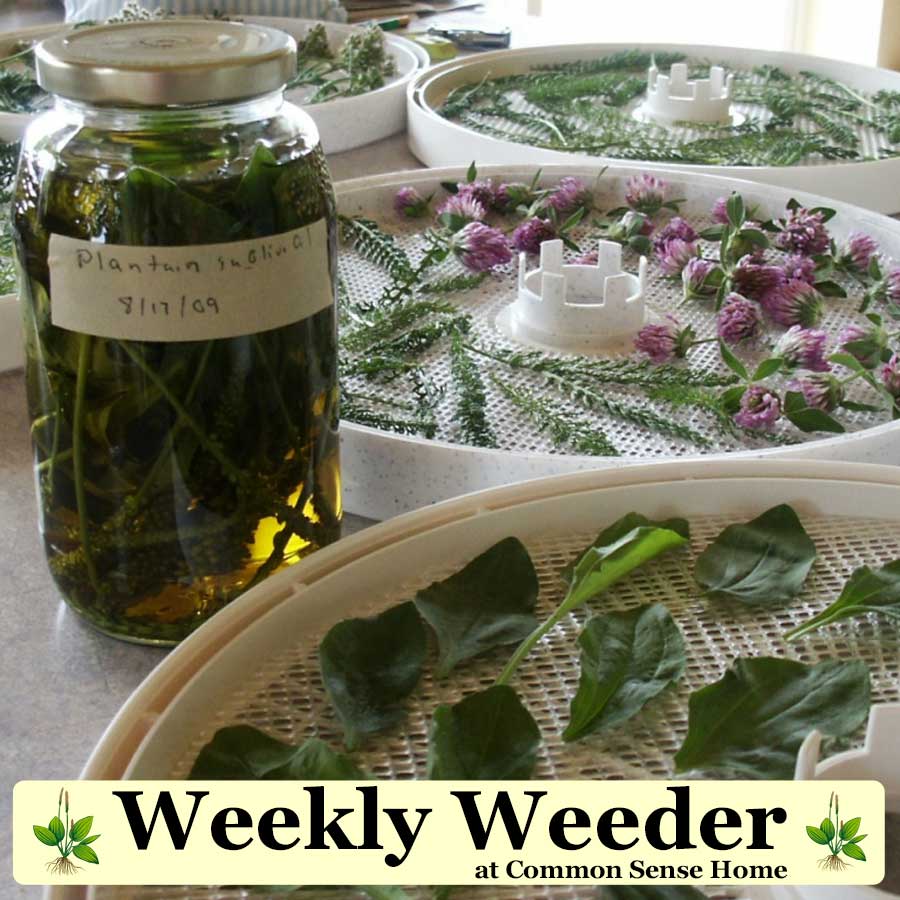
The Weekly Weeder Series
This article is #14 in the Weekly Weeder Series, a collection of posts I wrote some years ago about using wild plants for food and medicine. You can find the whole series on the Herbs and Wildcrafting page.
Other popular posts in the series include:
- Marvelous Milkweed – Answers to 21 Common Questions About this Useful Plant
- Stinging Nettle – One of Most Useful Wild Plants
- Catnip – Uses for People and Cats
Do you have a use for plantain that I missed, or a request for information on another wild plant? Leave a comment below and share your thoughts. If you’d be interested in a video course about the weeds we cover, let me know that, too.
Originally posted in 2011, updated in 2019.

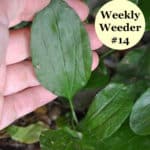
I like the way it tastes, kind of like a nutty banana and raw young baby spinach.
Thank you! knew they were great for bee stings, but had no idea that the plant was edible, and the seeds have fiber. Will add them to my dandalion diet. FANTASTIC!
They are one of my favorite wild plants.
Buck’s horn or stag’s horn plantain (erba stella or minutina in Italian, corne de cerf in French) is not the same as ribwort or narrow-leaf plantain, which is Plantago lanceolata. Buck’s horn has forking leaves (like a buck or a stag’s horn); its scientific name is Plantago coronopus, from the Greek meaning “crow’s foot.”
This is the problem with common names. Same or almost the same common name, different species. Plantago lanceolata is referred to as Buckhorn plantain. Plantago coronopus is Buck’s Horn Plantain.
Here’s an article from Michigan State University “Buckhorn plantain – Plantago lanceolata” using the buckhorn name.
Hello! I’m a beginner at making herb salves and tinctures. I have a question about picking the herbs. Is there a best time for doing this when the herb is at its peak for effective healing chemicals? Does this vary according to herb? For instance, I have lots of plantain in my yard, and I planted comfrey this past summer. I understand the comfrey takes a while to reach its maximum effectiveness for the allantoin chemical in it. But can these herbs (I’m leaving the comfrey alone until next year) be picked in the fall/winter/early spring as well as in summer to make effective poultice/salve/tincture? I’d like to make some more plantain salve, and it’s been a pretty mild fall here in northern Virginia. Should I wait til spring? Also, when is the best time of day (if any) to pick? Thank you!
The most common recommendations I’ve seen (and it’s possible some herbs may be different because there are a lot of plants out there) generally indicate that roots are best harvested in fall, when the plant has concentrated compounds in them in preparation for winter. Greens and flowers are typically harvested when they are in peak condition during the growing season.
Working with plantain, the only time I’ve run into trouble with potency is in years with exceptionally heavy rains. When I picked plantain that looked great but was growing in very wet soil and made it into salve, it did not stop the itching as it should. There’s unfortunately not a great way to deal with this if the rains won’t let up, which is why I try to store enough dry herbs to hold us over for two seasons, if possible. In the years of heavy rain, older dry herb is likely to work better than washed out fresh herbs.
For us here in Wisconsin, my late season plantain often has powdery mildew, so it’s not suitable for use. But if your plantain and other plants are in good condition, it should be fine to harvest them.
Will it also be beneficial to dry the leaves for tea to drink in fall and winter ?
Yes, the dried leaves aren’t quite as potent as fresh, but still helpful.
Hello, happy to have found your site, threw my friend, as lm big on herbs, you mentioned your grandmother making plantain salve, l don’t want incense oils only l like to use beeswax do you have any recipes
Could you rephrase that?
I live in Georgia how can I purchase this plant or the seed to grow it
Georgia the country or Georgia the state?
Do you know the exact nutritional profile of broadleaf plantain? How do you know the nutrients you list are even in it? Everyone on the internet has a generic list of nutrients like you do but I can’t find any proof, which would include the exact amounts for each nutrient.
If someone claims to have an exact nutritional profile of plantain, that profile would only be valid for the specific plant that was harvested under specific conditions – just like any domesticated crop.
For instance, I’ve noticed that when we harvested plantain under extremely wet conditions, the salve we made from the leaves didn’t work as well. I’d assume those particular plants also weren’t likely to be as high in nutrients.
If you are unwilling to trust advice on the internet, I’m sure there are labs that you can hire for nutrient analysis. While you’re sending in samples of wild plants, you may also want to get cultivated plants tested, too. I can guarantee there will be variations in nutrient value depending on variety, growing conditions, storage conditions, and other factors.
How long does it keep?
How long does what keep?
The fresh herb, the dried herb, the salve, the seeds?
Fresh herbs will last several weeks in the fridge. Dried herb will last a couple of years. Salve I usually make annually. Seeds, I’m not sure.
Hi, I am a retired nurse who has dabbled in herbology for my entire adult life. During the recent pandemic I was severely troubled by an impacted molar. Of course all the dentists were shut down short of a severe emergency and I did not wish to qualify as such. I finally decided to try plantain, being a leaf that draws and is also edible, it should at least give me some relief and swallowing it inadvertently during the night should not be an issue. (While I’d not recommend this part, I pierced the gum over the infection to facilitate drainage. I put my poultice of plantain leaf in place and left it overnight. To my delight I was able to wait until the the Delta strain subsided, this took about two months. I used the poultice every time the tooth flared until I got into the dentist and on to the oral surgeon for an extraction.
Happy Herbalist. 🙂
I’m glad it was able to buy you some time.
How the heck can I get some land to farm? I can’t manage to escape the suburbs, I will never have enough savings while living here…
All I want to do is homestead or farm and live on my farm. I grow everything in the small suburban backyard organically following things like Native American suggestions, The Four Sisters, or planting flowers and decoy crops to attract pests or attract pollinators, crop rotation, the whole nine yards. But it’s not enough. I have about 100 sq ft of grow space. That’s nearly good for nothing relative to the time I have to spend. For a marginal increase in time and slight increase in efficiency, I could farm an entire acre (after it’s prepared of course, which is indeed hard work).
Anyway, just my suburb spiel. I hate it.
Could you possibly work for a CSA share close by? I know that doesn’t get you out of the suburbs, but it could get you more food, and time with people who might have some connections that could get you out of of the suburbs.
I use it for bruising, it gets rid of the the bruise overnight! My granddaughter played in a soccer tournament, she had a bruise shaped like the soccer ball on her hip. She was going to Cuba, she asked what would work to get rid of the bruise. I told her to use the plantain salve. She did, the next day her bruise was gone!
Excellent! Thank you for sharing your experience.
This plant is good for rabid dog bite, snake bite, almost every wound, Maria Treben’s book says. It heals wounds even if it’s 10 years old, or nothing else helps, but only fresh one crumbled between the fingers or mortar.
What are your thoughts on mineral oil?
I prefer not to use mineral oil for skin care, as it can clog pores. As I understand it, most petroleum based products actually form a layer on the skin, not allowing it to properly breathe. Over time, rather than helping the skin to normalize its own moisture levels, this creates a dependency on the petroleum product. I do use mineral oil on my cutting boards.
Wondering if you ever use the seeds for anything?
I haven’t, but they are supposed to be very high in insoluble fiber. They use a related species to make Metamucil.
Nicole do you have any seeds you are interested in selling? The map says we are supposed to have it here in California but I have not been able to find any. I tried bringing home a couple plants after visiting family in
Wisconsin but I don’t know if they are going to make it.
I have seeds from last season, but I haven’t tested their germination rates. I do know that Mountain Rose Herbs stocks plantain seeds for planting, and I’m sure I’ll have fresh seeds later this season.
Add seeds to stews and soups or grind into flour.
First of all, let me thank you for a wonderful job. I love your site. I found fresh plantain in the ditch on the edge of our property! Am going to make the oil and then turn it into a sauve. Thought you might want to check out this site for your bees wax. I checked it today against mountain rose herbs and this place is over $2.00 a pound cheaper for the pellets and they are all organic I believe http://www.bulkapothecary.com
Rachelle
Thanks, Rachelle. I should be back to posting as normal next week. My computer got a bad virus this past week and we’re completely rebuilding this weekend.
For some reason I am not finding your recipe for making Plantain infused oil. What type of oil? How much? And how much fresh? dried? plantain? Makes how much? I am very interested in this recipe and in making the salve. Thanks, Rachelle
Rachelle – thanks for pointing out that my links were not going where they should be. The plantain infused oil instructions can be found in this post – https://commonsensehome.com/grandma-called-it-medicine-leaf/
I usually use a good quality olive oil because it has a very good shelf life.
I read this article about plantain a couple months ago and I wasn’t sure I had it in my yard. Well, I do! I am going to pick some now and get started on infusing olive oil and then use it for medicinal reasons. I will probably use your salve recipe. I can’t wait!
I’m so glad you found it. 🙂 It’s a must have around here for bug bites in the summer time.
Fantastic post on a such a versatile plant. It’s been the most popular suggested local treatment by readers of my post on bee stings.
Thanks.
THIS IS MY RED FOOTED TORTOISES FAVORITE “WEED” TO EAT WHEN HE GETS TO ROAM THE YARD. THIS AND DANDELION. NOW I MIGHT HAVE TO PICK SOME FOR MYSELF!
I made plantain salve for the first time a couple weeks ago after letting the infusion sit for 8 weeks… I love it! I made it just in time for my annual fall poison ivy out break…. works like a charm!
The oil infusion is good, but for a quicker cream heat 3 or 4 cups packed plantain finely chopped in a crock pot with 1-2 cups coconut oil, enough to cover + an inch or so, on high for 10-15 min., till hot. Then turn down to low for abt. 1hr. Turn off & let cool down 1-2 hrs. strain, add EO if desired. Sometimes I add a few stems of spearmint for scent or comfrey during heating, helps with sore muscles. This is great while waiting for your infusion! Also softer to use as a great face cream but may need to be kept in the fridge in hot weather. ENJOY!
Thanks, Theresa! There are so many great ways to use plant medicine that I think a person could study their whole lives and still have much to learn.